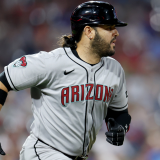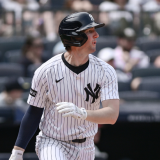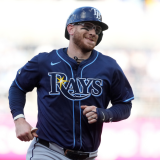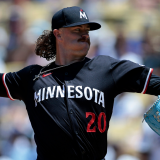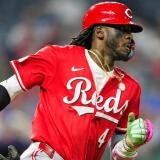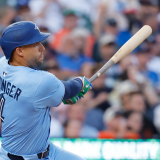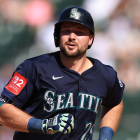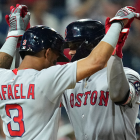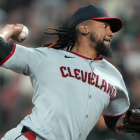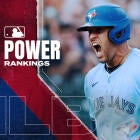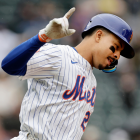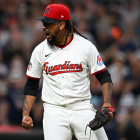
Could Cal Raleigh be even better? How a dead ball, an unfriendly ballpark are working against MVP candidate
The Mariners star is having a season for the ages, but the numbers may not tell the whole story

Seattle Mariners catcher Cal Raleigh launched his majors-leading 32nd home run of the season in a victory on Monday against the Minnesota Twins. Raleigh, who has already made history by slugging the most first-half home runs by a catcher, is now two homers away from matching his single-season career-high (34) before the All-Star Game. He's also, perhaps obviously, on pace to shatter the single-season record for most home runs hit by a catcher; that mark currently belongs to Kansas City Royals backstop Salvador Perez, who homered 48 times in 2021.
It doesn't take a deep dive to appreciate what Raleigh is doing this season. He trails just Aaron Judge in the American League MVP race (+550, per DraftKings). We do, however, reach an odd conclusion if you dive deep enough: Raleigh's effort has been more impressive than it appears. That's because there are a number of what we'll refer to here as "hidden factors" working against his offensive excellence.
Scroll slowly with us as we explain.
1. The ball is dead
If you like data then this is, without a doubt, the best time to have ever been a baseball fan. With a few clicks here and there, you can access metrics that break down just about any and everything there is to measure within the game. That includes, among other items, the ball's own traits.
Baseball Savant uses pitch-tracking data to measure the ball's "drag" on any given day. In layman's terms, that's a fancy way of describing how much air resistance the ball faces in flight.
A lively or juiced ball, often featuring lower seams, will face less drag/resistance as it cuts through the air. A dead ball, conversely, will have higher seams and face more drag/resistance. All things equal, a juiced ball will carry farther than a dead ball. To quote Savant directly: "a decrease in the drag coefficient of 0.01 will increase the distance of a batted ball with an exit velocity of 100 mph by approximately 5 feet (and an increase of 0.01 will decrease batted ball distance by 5 feet)."
You may recall that all sorts of home run records were falling in 2019. That's in part because the ball was as lively as it has been since 2016. It's notable, then, that Raleigh is putting on a personal home run derby every night while the ball is, on average, as dead as it has been over that time. Another way of thinking about it is that Raleigh would probably have even better numbers right now if the ball's innate characteristics more closely resembled others from recent years.
The ball isn't the only external factor working against Raleigh's onslaught, however.
2. Ballpark factors
Part of what makes Raleigh's season so special is that he's doing it for a Mariners team that isn't accustomed to huge home-run totals. Since 2000, the first full season at Seattle's current ballpark, the Mariners have enjoyed just three 40-plus-homer seasons and only 22 30-homer seasons. For comparison's sake, the Houston Astros have seen five and 28 of those respective efforts. The difference in those figures can be attributed to various aspects, including the teams' ballparks.
Playing surface, field dimensions, and atmospheric conditions can all impact performance. To account for that, analysts long ago created park factors, an attempt to quantify how much this or that statistic is impacted by the team's ballpark.
That's how we know that Raleigh's field isn't aiding his historic summer. Rather, Seattle's ballpark ranks 23rd in home-run factor for right-handed hitters and 16th for left-handed hitters, according to Baseball Savant. Raleigh, a switch-hitter, isn't benefiting either way.
Home run splits | As a RHB | As a LHB |
|---|---|---|
At home | 4 | 10 |
On road | 7 | 11 |
Perhaps it's no surprise then that the majority of Raleigh's long balls have come on the road -- that despite playing more home games to date. As with the ball above, it's anyone's guess as to how much more prolific he would be this season if he played in a friendlier offensive environment.
There's one other aspect worth considering that has likely worked to suppress Raleigh's numbers.
3. Physical demands
Raleigh being a catcher isn't hidden in the same way as the ball and ballpark factors, per se, but it's worth keeping in mind that backstops generally aren't competing for home run crowns for a variety of reasons. That includes, but isn't limited to, the physical toll of the position.
There's a reason that most starting catchers are parked at least once a week, usually for day games after night games. Raleigh's excellence has caused the Mariners to deploy him more frequently as a DH in those games, which has resulted in him carrying a bigger workload overall than his peers. Take a look at how Raleigh's start percentage compares to the other top-five catchers in the majors this season, as determined by FanGraphs' Wins Above Replacement:
| Player | Starts | Team games | Start% |
|---|---|---|---|
Cal Raleigh | 75 | 77 | 97% |
55 | 79 | 70% | |
60 | 77 | 78% | |
58 | 78 | 74% | |
74 | 79 | 94% |
Raleigh has started almost every single day this season. Contreras is the only other top catcher with a comparable workload, and even he's had more than twice as many off days. To put it another way: Raleigh has been in the lineup, either in the squat or as DH, for all but one game dating back to May 7 -- that's a lot to ask of anyone, let alone someone who catches most days.
Obviously the Mariners' demands of Raleigh haven't yet impacted his performance. But, as with the two other hidden factors presented here, it's all the more reason to view his year with awe.
![[object Object] Logo](https://sportshub.cbsistatic.com/i/2020/04/22/e9ceb731-8b3f-4c60-98fe-090ab66a2997/screen-shot-2020-04-22-at-11-04-56-am.png)


